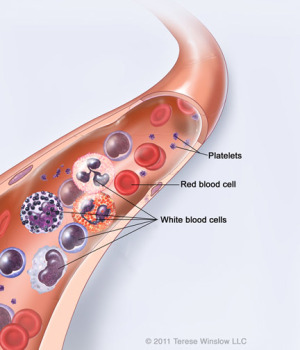 Blood studies are tests that examine a patient’s blood. They are the most common tests done for cancer patients. They help doctors follow the course of a patient’s disease and select the right treatment dosage.
Blood studies are tests that examine a patient’s blood. They are the most common tests done for cancer patients. They help doctors follow the course of a patient’s disease and select the right treatment dosage.
Blood can be drawn in a variety of ways, depending on your child’s situation. The most common way to draw blood is to insert a needle into a vein. However, children undergoing chemotherapy may have a central venous line in place from which blood can be drawn.
Supporting Your Child
Every child responds differently to getting his or her blood drawn. Some children like to know in advance if they are going to have blood drawn, others will become overly anxious. Some children prefer finger pokes, while others prefer the blood be drawn from a vein. Whatever the issues are for your child, you should try to find ways to give them some choices, such as which finger or arm to poke, so they feel they have some control.
If your child is anxious about needles, talk to a member of the treatment team. There are ways your child can be helped through medical play or relaxation to relieve their anxiety. For example:
- Ask that the person drawing the blood use EMLA to reduce discomfort.
- For younger children, it can be helpful to distract them from the needle.
- For older children, it can be useful to help them feel in control.
- Holding your child’s other hand or arm can provide comfort.
- Plan to do something fun after the blood is drawn. You can give a young child an award right after the test. This creates a positive association with blood tests.
It is important to understand your child’s preferences and how your child reacts. This way you can appropriately prepare your child in a way that reduces anxiety.
Types of Blood Studies
Complete Blood Count (CBC)
A complete blood count (CBC) is a test to thoroughly examine a person’s blood. It is the most common test done for children with cancer because it tells doctors how treatment is affecting the bone marrow, where blood cells are made. A CBC can identify when your child is ready for their next round of chemotherapy, if a transfusion is needed, or whether there is an increased risk for infection.
Blood can be drawn for a CBC in a variety of ways, depending on your child’s situation. The most common way to draw blood is to insert a needle into a vein. Blood can also be taken from a central venous line (a tube inserted into a large vein during a period of treatment).
Common Information Reviewed in a CBC
- White blood count (WBC) measures the number of white blood cells present in the peripheral blood (blood that circulates in the body). White blood cells help fight infection. Abnormal results could be a sign of infection, inflammation, cancer, bone marrow problems or other issues within the body.
- Diff (differential count) refers to the distribution of the various types of white cells in the peripheral blood; the values are expressed in percentages. These values change frequently in response to what is happening in the body. Increases in particular types of white cells can be signs of temporary or chronic conditions.
- Platelet count refers to the number or quantity of platelets (the smallest type of blood cell) present in the blood. Platelets prevent bleeding by helping the blood clot. The platelet count can be used to monitor or diagnose diseases. Significant decreases in the platelet count could mean that someone is at risk for bleeding in any part of the body.
- Hemoglobin refers to the substance found in red blood cells that carries oxygen to other tissues of the body. It is expressed as a percentage of total blood weight. High numbers could be the result of dehydration or problems with the kidneys. Low numbers indicate anemia, which could be the result of blood loss, problems with bone marrow, malnutrition or other issues.
- Hematocrit measures the percentage of red blood cells in a given volume of whole blood. High numbers could be the result of dehydration or problems with the kidneys. Low numbers indicate anemia, which could be the result of blood loss, problems with bone marrow, malnutrition or other issues.
- Retic (reticulocyte count) refers to the percentage of young, non-nucleated erythrocytes (red blood cells) present in peripheral blood. It helps doctors determine the rate at which red blood cells are being created within the bone marrow.
Blood Chemistry Studies (CMP or BMP)
Blood chemistry studies provide information about how your child’s organs (such as liver and kidneys) are functioning. It is especially important to monitor organ function during cancer treatment. These studies also show if the levels of sodium, potassium and many other elements in the blood are normal.
Blood can be drawn for blood chemistry studies in a variety of ways, depending on your child’s situation. The most common way to draw blood is to insert a needle into a vein. Blood can also be taken from a central venous line (a tube inserted into a large vein during a period of treatment).
